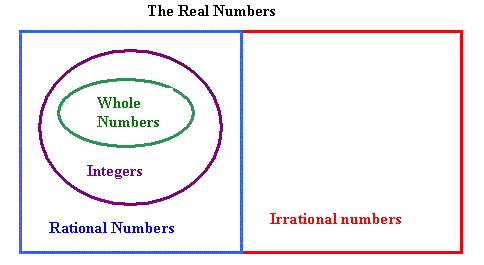|
|
|
|
Whole numbers are positive counting numbers.
Whole numbers do not have any decimals and they cannot be fractions. The whole numbers are {0,1,2,3,4,5,...} |
 |
Integers are the positive and negative counting numbers.
Integers do not contain decimals and they cannot be fractions {Whole numbers} Ì {Integers} The Integers are {...-5,-4,-3,-2,-1,0,1,2,3,4,5,...} |
|
Rational numbers are any number that can be expressed as a ratio of two integers
(a ratio being one number placed over another with a "/" in between-we will examine this more
thoroughly in the unit on fractions)
{integers} Ì {Rational numbers} The Rational numbers include decimals, and fractions. Just as an example of some Rational numbers, {1/3, 5/1 (=5), -2/3, -2/1 (=-2), 0.56, -0.02} Ì {Rational numbers} |
The Irrational numbers are any number that cannot be expressed as a ratio of two integers
The greek constant pi, (p) which is used in calculating the area and curcumference of a circle, is one example of an Irrational number. p is approximately equal to 3.14 When you come to square roots later in this tutorial, you'll see other Irrational numbers |
The Real numbers encompass everything
{Real numbers}={Rational numbers} È {Irrational numbers}. |
I know this isn't the most exciting subject but believe it or not these properties are how subjects like algebra work. Just drink a cup of coffee to stay awake, and it will be over in a minute